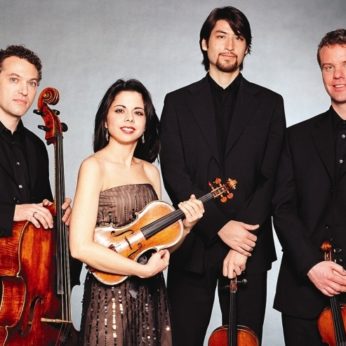There have been, and will be thousands of princes; there is only one Beethoven. So raged the composer when he felt insulted by one of his patrons insisting that he play for him and his guests. The truth of this is made plain to us when you think of the thousands and thousands who only know the name of Count Razumovsky, the Russian Ambassador to Vienna, because he commissioned the three opus 59 quartets. When giving Beethoven the commission, the Ambassador requested that he include a Russian theme in each of the quartets. The composer complied with this condition in the first two works in the set, but in this work there is no recognisable Russian tune, though it is generally felt that the second movement has Russian overtones.
The harmonically mysterious introduction is surely a reference to Mozart’s famous Dissonance Quartet, also in C major. The composer Robert Simpson was convinced that this work charts Beethoven’s grappling with the terrible fact of his deafness, which he had already been struggling with for several years. Certainly he wrote on the sketches for the last movement: Make no secret of your deafness, not even in art.
The strange, confused world of the introduction is followed by two chords and a concertante display by the first violin. This leads directly into the brilliance of a C major Allegro, power-driven by an enormous, exuberant energy bursting out in every direction. The second subject temporarily slows the pace before the exposition is rounded off by the driving rhythm led by the cello. After the repeat, the development concerns itself with the virtuosity of the first violin and the questioning phrases of the second subject, sensibly leaving the boisterous main theme out of the argument. The recapitulation lets him in again but the coda brings the movement to an uncertain end, almost as directionless as the opening.
Robert Simpson saw the second movement as describing the solitary imprisonment to which Beethoven’s deafness confined him. This is a fanciful description, but few people have had a deeper knowledge of Beethoven’s quartets. The sketches for this movement also show the repeated note theme that ends up as the Allegretto of the Seventh Symphony, also in A minor and also dominated by a strong rhythmical line. In the quartet this is provided by the inspired pizzicato in the cello, the foundation of the movement’s plaintive melancholy.
The third movement is a relaxed minuet harking back to Mozart again, a gracious and stylised dance reminiscent of the rococo era. The Trio is more dynamic and forceful with some spectacular decorations. This easeful interlude is doubtless intended as a contrast to the irresistible force of the fugal finale, which explodes upon us like a whirlwind. It develops into a near moto perpetuo that is a virtuoso showpiece for the players, and its high spirits display Beethoven’s energetic mastery of the medium.
